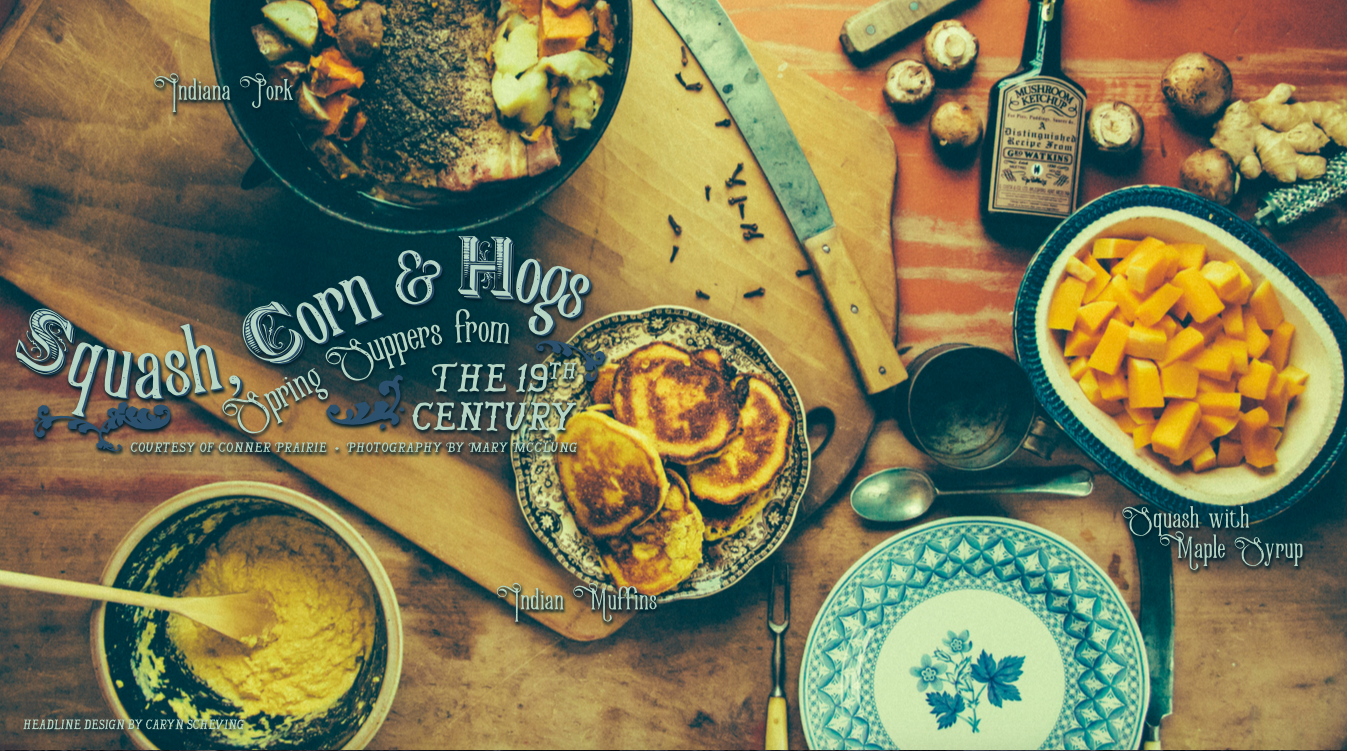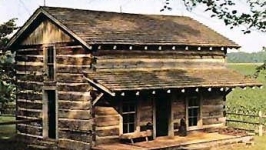Spring Suppers from the 19th Century: Squash, Corn and Hogs
Squash, corn and hog, the staples of the diet of early European settlers to Indiana, didn’t all come west as the settlers did.
The non-native travelers to the future state of Indiana would have found squash and corn in abundance in Native American gardens and fields. Many of the tribes in Indiana were great farmers, planting acres of corn, beans and squash along with other crops.
The hogs came along with later settlers and became an integral part of the Hoosier diet. Hams and bacon were easily cured to last throughout the year. Cuts, like the loin, needed to be used quickly and were shared among the neighbors who had come to help with butchering. The weinerschnitzel familiar to German settlers became today’s pork tenderloin. Pigs remain an important part of our economy with Indiana in fifth place in pork production within the U.S. Cornbread, squash and maple syrup all still make regular appearances on Indiana dinner plates.
Here are some recipes from Indiana’s early days:
Cornbread
An important part of the Hoosier economy since before European settlement began, corn would grow well on newly cleared ground while other grains only thrived after the ground had been farmed for a few years. Corn could be ground at home if it was difficult to get to your local gristmill.
Indian Muffins
Beat five eggs light, stir them into a quart of milk with a small handful of flour and a tea-spoonful of salt; then stir in as much fine Indian meal (cornmeal) as will make a tolerably thick batter. Having buttered some little scalloped muffin pans, place them in an oven that is moderately heated*, put in each a small ladleful of the batter and bake them a nice brown; then take them from the pans, arrange them neatly in a plate, lay on the top of each a slice of firm butter, and eat them warm.
* Remember, controlled heat is a modern-day luxury and these recipes would’ve been cooked over a fire. In a conventional oven, it’s recommended muffins be baked around 350–375°F.
Squash with Maple Syrup
Squash is one the “Three Sisters” planted in many Native American gardens, along with corn and beans. Winter squash was easily dried and stores well if kept from freezing. The syrup from our native sugar maple trees is a great complement to the flavors of the squash.
Wash, peel and slice squash or pumpkin. Place into kettle, add water to cover. Add small amount of salt. Boil until tender. Place in dish and pour small amount of maple syrup over the squash. Serve.
Recipe courtesy of A Woodland Feast: Native American Foodways of the 17th & 18th Centuries, by Carolyn Raines.
Pork
Hogs had an advantage over other livestock of being able to care for themselves in the woods of the Indiana frontier. Not dependent on humans for food, a herd of hogs could defend themselves from wolves, bears and wildcats until you needed to gather a few for butchering.
To Bake Pork
Take a leg, shoulder, or a part of the middling, rinse it clean, and score the skin crosswise, so as to form diamonds, season it with salt, pepper, and sifted sage; brush it over with sweet oil, lard, or butter, and put it in an oven* with a small quantity of water, having placed in the bottom some suitable vegetable, such as squash, tomatoes, sweet, or white potatoes. Bake it with moderate heat, till it is thoroughly done. If the meat is large, it would be best to bake it till about half done, before the vegetable is put in. Thicken the gravy with brown flour, and flavor it with any kind of catchup you choose.
* We recommend an oven heated at 350°F.
Recipe courtesy of Kentucky Housewife, by Mrs. Peter A. White, 1839.
Mushroom Ketchup (More like a Worcestershire sauce)
Take the large Flaps of Mushrooms, pick nothing but the Straws and Dirt from it, then lay them
in a broad earthern Pan, strow a good deal of Salt over them, let them lie till next Morning;
then with your Hand brake them, put them into a Stew-pan, and let them boil a Minute
or two, then strain them thro’ a coarse Cloth; and wring it hard. To take out all the Juice,
let it stand to settle, then pour it off clear, and run it thro’ a thick Flannel Bag, (some filter it thro’ brown Paper, but that is a very tedious Way) then boil it, to a Quart of the Liquor put a quarter of an Ounce of whole Ginger, and half a quarter of an Ounce of whole Pepper, boil it briskly a quarter of an Hour, then strain it, and when it is cold, put it into Pint Bottles; in each Bottle put four or five Blades of Mace, and six Cloves, cork it tight, and it will keep two Years. This gives the best Flavour of the Mushrooms to any Sauce.
Recipe courtesy of The Art of Cookery Made Plain and Easy, by Hannah Glasse, 1747.
About Conner Prairie
Spanning 850 wooded acres in Central Indiana, Conner Prairie welcomes more than 360,000 visitors of all ages annually. As Indiana’s first Smithsonian Institute affiliate, Conner Prairie offers various outdoor, historically themed destinations and indoor experiential learning spaces that combine history and art with science, technology, engineering and math to offer an authentic look into history that shapes society today. Conner Prairie is located at 13400 Allisonville Rd., Fishers. You can reach them at 317.776.6000 or at http://ConnerPrairie.org.






